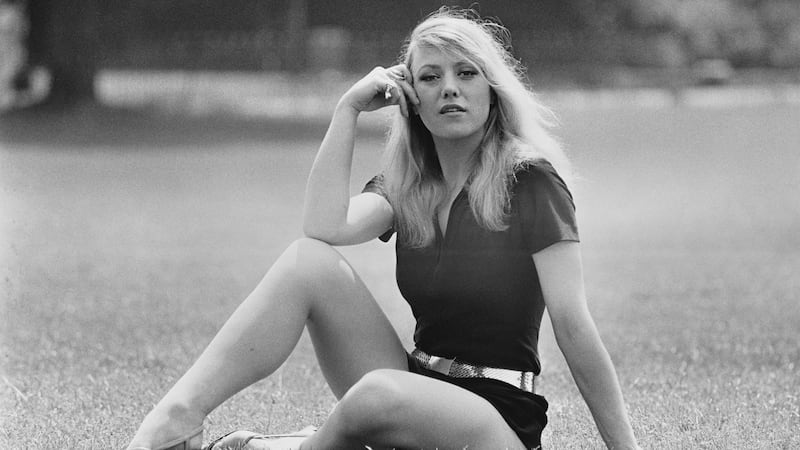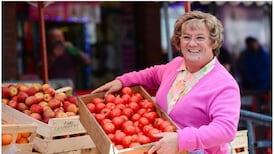Margaret Nolan, a stage and screen actress whose gold-painted body was used as a canvas to project the opening credits of the James Bond film Goldfinger and who played the character Dink in the movie, has died. She was 76. She died at her home in Belfast Park, London, on October 5th. The cause of death was cancer, said her son Oscar Deeks, who confirmed her death.
In a career that was predominantly in the 1960s and 1970s, Nolan appeared in numerous BBC television productions and in films, including No Sex Please, We’re British (1973) and Carry On Girls (1973). She also appeared in A Hard Day’s Night (1964), the musical comedy featuring the Beatles.
She appeared in an uncredited role as Grandfather’s Girl at Casino, according to the IMDb.com. But it was the opening title sequence of Goldfinger” (1964), which was projected on to Nolan’s body as if it were a screen, that brought her fame.
“Squeezed into a gold leather bikini, her skin painted the same shimmering hue, the statuesque starlet Margaret Nolan (41-23-37) stood still while scenes from the just-finished James Bond movie Goldfinger were projected on to her curves, The New York Times reported in 2005 of the film shoot, which it also described as “long and meticulous”.
The movie’s title sequence went on to be a featured exhibition at the Museum of Modern Art in 2012-13. In an archived version of her official website, Nolan described how she was “quite unexpectedly shot into the limelight” by the movie when she was only 20.
The filmmakers wanted her to be the body for the title sequence, but she agreed to do it only if she were given a role in the movie. She ended up playing a masseuse named Dink who appears briefly with James Bond, played by Sean Connery.
Nolan’s character in Goldfinger was not to be confused with the character who is completely painted in gold and dies of “skin suffocation.” That character, Jill Masterson, was played by Shirley Eaton. (That scene also prompted false accounts that the actress had died during the filming as a result of the paint.)

Nolan turned down a two-year contract to publicise the film because she said she would find it difficult to live down such attention and wanted to be taken seriously as an actor. “As it transpired, I couldn’t ‘live it down’ anyway and to this day get regular fan mail from Bond fans!” she wrote.
Margaret Ann Nolan was born in Hampstead, London, on October 29th, 1943. Her father, Jack Nolan, was a clerk in the army, and her mother, Molly, was a psychiatric nurse. Her mother relocated the family to Co Waterford during the second World War, where they stayed until it ended.
The family returned in 1946 to Hampstead and Nolan was training to be a teacher when she met her first husband, Tom Kempinski, who was then an actor with the National Theatre. “He convinced me that I could be an actress,” she wrote. She gave up acting in the late 1980s to focus on homemaking and caring for her two sons, Deeks and Luke O’Sullivan, and in the early 1990s moved to Andalusia, Spain, where she took up drawing and painting.
Her first marriage to Kempinski ended in divorce, as did a second marriage to Mike O’Sullivan. She began making photomontages from some of her earlier portraits and had her work featured in exhibitions. She also became politically active in the Workers Revolutionary Party, Deeks said.
She developed a passion for permaculture, a movement coined in the mid-1970s as a portmanteau of permanent agriculture and permanent culture. At her farmhouse in Spain, she lived off the grid and relied on solar energy, Deeks said.
The director Edgar Wright said on Twitter that Nolan played a small role in his upcoming movie Last Night in Soho. He described her as being in the middle of a Venn diagram of “everything cool in the ’60s” having appeared with the Beatles and in the Bond film.
She returned to the screen in a low-budget independent film The Power of Three (2011), which she described as a feel-good comedy that reinvents the myth of middle age. In a 2012 interview with the site Playerist, she was asked if she wanted to escape glamour or to embrace and use it. “I absolutely embraced it when I was able to, when I was glamorous,” she said. “You don’t go on embracing it – that is pathetic. It was just part of being young and beautiful.”
In addition to her sons Deeks and Luke, Nolan is survived by a sister, Geraldine Ross. – New York Times










